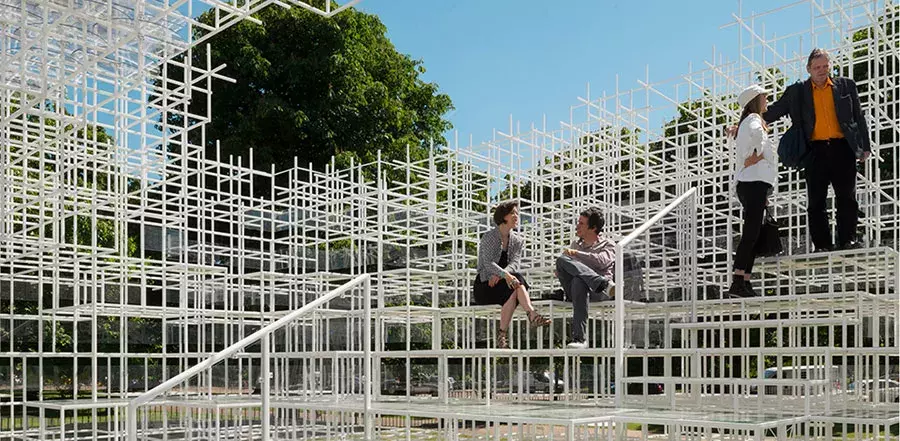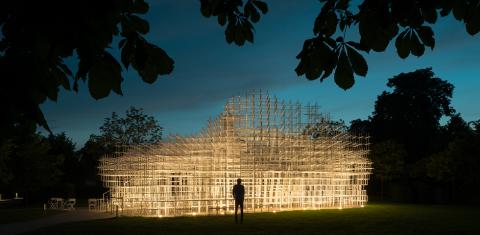
All around Los Angeles, you can see examples of modernist architecture, including the iconic case study houses of architects like Richard Neutra, Pierre Koenig, and Charles & Ray Eames. These visionaries and their successors were influenced deeply by traditions of Japanese architecture, which can be seen in their clean lines, open interior spaces, and attention to natural light and setting. But the story of Japanese architecture doesn’t stop with its influence on modernism and minimalism around the world. Today, Japan can claim an outsize number of award-winning architects who are sought-after for major projects worldwide. Here is a selection of five names you should know in learning about Japan’s current architecture scene.
(In alphabetical order: Tadao Ando, Shigeru Ban, Sou Fujimoto, Arata Isozaki, SANAA)
1. Tadao Ando
Tadao Ando is one of the godfathers of contemporary Japanese architecture, and won the Pritzker Prize (the highest honor in the field) in 1995. Born in 1941 in wartime Osaka, he worked as a truck driver and a boxer before becoming a self-trained architect – a career change inspired by his encounter with the works of Frank Lloyd Wright and Le Corbusier (who themselves had been inspired by Japanese architecture). He’s best known for minimalist, sensitive spaces that provoke contemplation – such as his “Church of Light” in Osaka, and the Benesse House on the art island of Naoshima. Ando’s signature material is grey concrete, and he even uses his own special recipe to mix it. It’s an element that can be heavy or even brutal, but in Ando’s hands, appears almost weightless, suspended in light.
2. Shigeru Ban
Above all else, the purpose of architecture is to provide shelter for humans. Tokyo-born Shigeru Ban has never forgotten this basic mission, and it has guided his career as an innovator in materials and design, as well as a humanitarian. As the founder of the Voluntary Architects Network, Ban pioneered the use of humble materials like paper and cardboard-tubing to create affordable DIY shelters for refugees and disaster victims in places like Rwanda and Turkey, as well as in Kobe, Japan (after the 1995 earthquake). But whether designing for disaster relief or for more permanent structures (like the Centre Pompidou-Metz Museum), Ban’s Pritzker Prize-awarded body of work reveals that architecture is ultimately just a frame for the human experience – and the frame can be beautiful and sustainable at the same time.
3. Sou Fujimoto
At only 41, the Hokkaido-born Sou Fujimoto is part of the younger generation and could be considered a bit of a “mad scientist” – in fact, he wanted to be a physicist before turning to architecture. His works explore the boundary between organic and artificial, nature and humanity, tangible and intangible. He has constructed houses based on the structure of a tree, a chambered seashell or geometric minerals. For London’s Serpentine Gallery in 2013, he created a pavilion in the shape of a “latticework cloud”, that quickly became a visitor favorite. He’s even worked on the smaller scale of interior and furniture design, such as a bookshelf with an invisible embedded chair, as well as installation art – any canvas to get his boundary-breaking ideas across.
4. Arata Isozaki
Arata Isozaki’s work should be familiar to anyone who has been to downtown Los Angeles – he designed the landmark Museum of Contemporary Art on Grand Avenue (opened in 1986). But Isozaki’s career stretches back to the 1960s, and can be seen as a link between one era of Japanese architecture and the next. After apprenticing under mid-century giant Kenzo Tange, Isozaki began designing his own buildings that blended Western modernism (and so-called “brutalism”) with new Japanese avant-garde aesthetics, such as the “Metabolism” movement, a post-war Japanese architectural movement that fused concepts of architectural megastructures with those of organic biological growth. He later embedded wit and playfulness into structures like the 1974 Fujimi Country Club house in his native prefecture of Oita, which has a question-mark for a roof, and the bulbous “Ark Nova” inflatable concert hall in collaboration with Anish Kapoor which benefitted quake-affected areas in northern Japan in 2013. At age 86, he shows no signs of slowing down – his ambitious high-rise design for the anticipated CityLife Tower in Milan, Italy, will be opening soon.
5. SANAA (Kazuyo Sejima & Ryue Nishizawa)
In 1995, Kazuyo Sejima joined forces with her former protégé Ryue Nishizawa to establish a new collaborative studio, entitled SANAA (an acronym for “Sejima and Nishizawa and Associates”). Ever since, they’ve been creating deceptively subtle structures around the world that prioritize human experience and adaptive use. From the off-kilter metal cubes of the New Museum in New York, to the looping walkways of the Rolex Learning Center in Lausanne, Switzerland, SANAA knows how to design for the eye, but is just as interested to design for the body in space – whether it is walking, sitting, or merely standing still. Sejima has said she wants architecture to be “like a park” – not just a pleasant environment, but one that can be used for various purposes at the same time. In 2010, SANAA became only the second duo to ever win the Pritzker Prize, and Kazuyo Sejima only the second woman (after Zaha Hadid).

Serpentine Gallery Pavilion 2013 Designed by Sou Fujimoto
© 2013 Jim Stephenson
